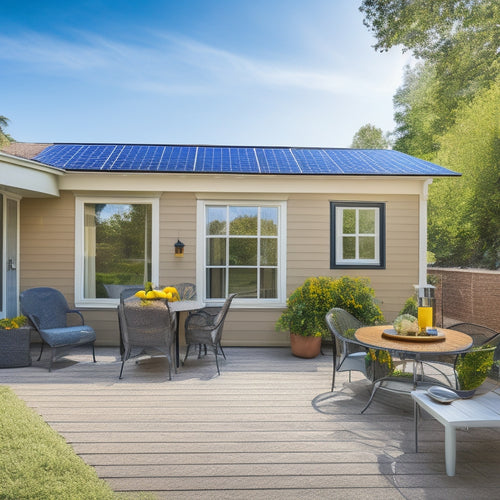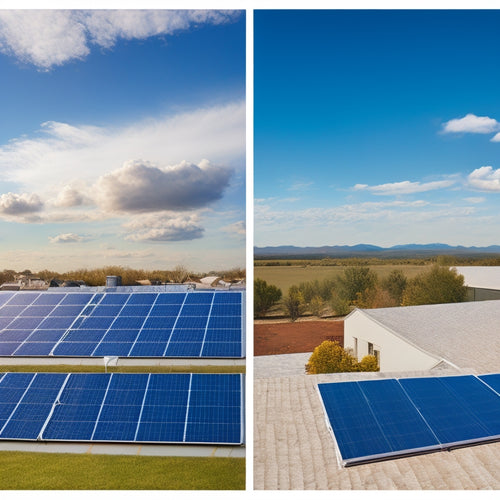
How to Install Off-Grid Solar Panels for Your Home
Share
You'll start by evaluating your energy needs, tracking daily usage to identify inefficiencies and make lifestyle adjustments to enhance energy efficiency. Then, choose the right equipment, selecting solar panels based on efficiency, wattage, and durability, and sizing your system to meet specific energy requirements. Next, select a suitable location, evaluating roof condition, orientation, and tilt for maximum energy output. You'll also need to prepare your roof structure, install solar panel mounts, connect the panels, set up battery storage, and configure charge controllers. As you work through these steps, you'll be well on your way to achieving energy independence and uncovering the full benefits of off-grid solar power.
Key Takeaways
- Assess your energy needs by tracking daily usage to right-size your solar panel system and maximize utility incentives and cost savings.
- Choose high-efficiency solar panels and equipment that meet your specific energy requirements and withstand harsh weather conditions.
- Ensure your solar system is properly sized to generate and store energy efficiently, considering charge controllers, inverters, and battery banks.
- Select a suitable location for your solar panels, considering factors like shading patterns, roof condition, orientation, and tilt for optimal energy output.
- Install your solar panel system securely, following manufacturer instructions and local building codes, and ensure proper electrical connections and battery storage.
Assessing Your Energy Needs
Typically, homeowners considering off-grid solar panels overlook the essential step of evaluating their energy needs, which can lead to an inefficient system. To achieve true grid independence, you must accurately assess your energy consumption and usage patterns.
This involves tracking your daily energy usage, identifying areas of inefficiency, and making lifestyle adjustments to optimize energy efficiency. By doing so, you can right-size your solar panel system, ensuring it meets your specific energy needs without overspending on unnecessary capacity.
Furthermore, understanding your energy needs helps you take advantage of utility incentives, maximize cost savings, and reap long-term benefits from your investment in renewable resources.
Don't underestimate the importance of this step – it's critical to minimizing your environmental impact and achieving a sustainable, off-grid lifestyle.
Choosing the Right Equipment
You'll need to select solar panels that meet your energy requirements, considering factors like efficiency, wattage, and durability.
Next, you'll size your system to guarantee it can handle your energy needs, factoring in variables like battery capacity and charge controllers.
Solar Panel Selection
Ideal energy harvesting begins with a thoughtful selection of solar panels, as they form the backbone of your off-grid system. When choosing solar panels, you'll encounter various types, each with its strengths and weaknesses. You'll need to decide between monocrystalline, polycrystalline, and thin-film solar panels.
Monocrystalline panels offer high efficiency ratings (up to 22%) but are more expensive. Polycrystalline panels are a cost-effective alternative, with slightly lower efficiency ratings (up to 18%). Thin-film panels are the most budget-friendly option, but their efficiency ratings are generally lower (up to 14%).
Efficiency ratings are vital, as they determine how much power your system can generate per hour of sunlight. Look for panels with high efficiency ratings (above 18%) to maximize your energy output.
Additionally, consider the panel's wattage, temperature coefficient, and durability. Be certain to check the manufacturer's warranty and certifications, such as UL (Underwriters Laboratories) or IEC (International Electrotechnical Commission).
System Sizing Considerations
With your solar panels selected, it's essential to determine the right equipment for your off-grid system. You need to guarantee that your system can efficiently generate and store energy to meet your power needs.
To achieve this, consider your energy independence goals and budget planning. Calculate your daily energy requirements and size your system accordingly. This will help you optimize solar efficiency and reduce your reliance on grid alternatives.
When choosing your equipment, consider the maintenance schedules and potential system expansion plans. A well-designed system should be scalable to accommodate future energy needs.
Look for high-quality components that can withstand harsh weather conditions and provide reliable performance. Your system should include a suitable charge controller, inverter, and battery bank that can store excess energy generated during the day for use at night or during power outages.
Mounting Hardware Options
Selecting the right mounting hardware is vital to guarantee your off-grid solar panels operate efficiently and safely.
You'll need to evaluate various options, including ground mounts, pole mounts, and flush mounts, each suited for specific installation scenarios. Adjustable mounts and tilt mounts provide flexibility regarding panel orientation, assuring ideal energy harvesting. Rail systems and tracking systems can be used to secure and position your panels for maximum energy output.
When choosing your mounting hardware, don't forget to take into account aesthetic considerations, such as the visual impact on your property.
You'll also need to verify you have the necessary installation tools to get the job done efficiently. Material durability is essential, as your mounting hardware will be exposed to the elements.
Look for hardware made from high-quality, weather-resistant materials that can withstand the test of time. By selecting the right mounting hardware, you'll be able to maximize your energy output, reduce maintenance, and enjoy a reliable off-grid solar power system.
Selecting a Suitable Location
When selecting a suitable location for your off-grid solar panels, you'll need to assess shading patterns to verify your system receives ideal sunlight.
You must also evaluate the condition of your roof to confirm it can support the weight and structural integrity of the panels.
Additionally, consider the orientation and tilt of your roof to maximize energy output.
Assessing Shading Patterns
Because your off-grid solar panel system will rely heavily on sunlight, identifying potential shading patterns is essential in selecting a suitable location.
You'll need to conduct a thorough shading analysis to determine the best spot for your solar panels. This involves evaluating the amount of sunlight exposure your location receives throughout the day and year.
To do this, consider the following factors:
-
Tree coverage: Are there any trees nearby that could cast shadows on your solar panels? If so, will they grow taller and create more shading in the future?
-
Building orientation: How will the surrounding buildings and structures affect the sunlight exposure of your solar panels? Will they cast shadows during certain times of the day?
-
Seasonal changes: How will the changing seasons impact the sunlight exposure of your solar panels? Will the sun's angle change throughout the year, affecting the amount of shading?
Evaluating Roof Condition
Now that you've assessed shading patterns, you're ready to evaluate the condition of your roof to determine if it's a suitable location for your off-grid solar panels. This involves conducting a thorough roof inspection to identify any potential issues that could affect the performance or longevity of your solar panel system.
Using advanced roof inspection techniques, examine your roof for signs of wear, damage, or deterioration. Check for missing, loose, or damaged shingles, curled or buckled shingles, and signs of animal or insect infestation.
Also, inspect the roof's structural integrity, including the condition of rafters, trusses, and flashing.
Roof material considerations are also essential. Verify that your roof is made of a material compatible with solar panels, such as asphalt shingles, metal, or tile.
Avoid roofs with sensitive or fragile materials, like slate or cedar shakes, which may be damaged during installation.
Orientation and Tilt
Maximizing the orientation and tilt of your off-grid solar panels is crucial to enhance energy production and guarantee a successful installation.
When selecting a suitable location, you'll want to take into account the solar panel orientation and ideal tilt to confirm you're utilizing the most energy from the sun.
To get it right, follow these guidelines:
-
Face south: In the northern hemisphere, a south-facing orientation is optimal, as it receives the most direct sunlight throughout the day.
-
Tilt at your latitude: The ideal tilt angle is equal to your latitude, plus or minus 15 degrees. This guarantees the panels are angled perfectly to capture the sun's rays.
-
Avoid shading: Confirm the location you choose is free from shading, including trees, buildings, and other obstacles that could block sunlight.
Preparing Your Roof Structure
As you gear up to install off-grid solar panels, verifying your roof structure is ready for the additional weight and stress becomes essential.
You'll need to assess the roof load capacity to confirm it can support the weight of the solar panels, mounting hardware, and any potential snow or wind loads.
Verify the structural integrity of your roof by checking for any signs of damage, rot, or weakness. Weather resistance is vital, so inspect your roofing materials for any signs of wear or damage.
Before installation, secure the necessary installation permits from your local authorities. Guarantee easy maintenance access to the roof and consider drainage considerations to prevent water accumulation.
Additionally, consider the aesthetic impact of the solar panels on your home's exterior.
Finally, review local regulations and building codes to confirm compliance with energy efficiency standards.
Installing Solar Panel Mounts
With your roof structure prepared, you're ready to move on to the next step: installing solar panel mounts. This is a critical component of your off-grid solar panel system, as it guarantees your panels are securely fastened and angled for maximum energy production.
When it comes to mount installation techniques, you have several options to choose from:
-
Roof Mounts: These are the most common type of mount, attached directly to your roof's rafters. They're suitable for most roof types and provide a secure, watertight seal.
-
Ground Mounts: These are ideal for homes with metal or tile roofs, or for those who prefer a more flexible installation. Ground mount options include fixed-tilt and tracking systems, which can be adjusted to enhance energy production.
-
Ballasted Mounts: These are a type of roof mount that uses weighted blocks to secure the panels, rather than penetrating the roof surface. They're suitable for flat or low-slope roofs.
Regardless of the mount type you choose, it's crucial to follow the manufacturer's instructions and local building codes to guarantee a safe and efficient installation.
Connecting the Solar Panels
Efficiency begins with a solid connection. When connecting your solar panels, you'll need to guarantee that the wiring techniques you use are secure and reliable. Start by identifying the positive and negative terminals on each panel, and use the correct wiring configuration to connect them in series or parallel, depending on your system's requirements.
Make certain to use weather-resistant connectors and seal them properly to prevent water ingress.
Safety precautions are vital when working with electrical connections. Always turn off the power to the system before making any connections, and use protective gear like gloves and safety glasses.
Verify that the wiring is sized correctly for the system's voltage and current, and that all connections are secure and won't come loose over time. Use torque wrenches to tighten connections to the recommended specification, and inspect the wiring regularly to guarantee it remains in good condition.
Setting Up Battery Storage
To guarantee a reliable and efficient off-grid solar panel system, you'll need to set up a suitable battery storage solution. This is because your solar panels will generate electricity during the day, but you'll need a way to store that energy for use during the night or on cloudy days.
-
Choose the right battery type: You'll need deep-cycle batteries designed for off-grid solar systems, which can handle frequent charging and discharging. Popular options include lead-acid, lithium-ion, and nickel-cadmium batteries.
-
Determine your storage capacity: Calculate your energy needs based on your daily energy consumption, and select a battery bank that can provide enough power during periods of low solar production.
-
Implement battery management: A battery management system (BMS) is vital for monitoring and controlling your battery's state of charge, voltage, and temperature.
This guarantees safe and efficient charging and discharging, and prevents damage to your batteries. Effective battery management is key to a reliable and efficient off-grid solar panel system.
Configuring Charge Controllers
Configuring Charge Controllers
Most off-grid solar panel systems require at least one charge controller to regulate the flow of energy from your solar panels to your battery bank. This essential component prevents overcharging, which can damage your batteries, and guarantees efficient energy harvesting.
When choosing a charge controller, you'll need to take into account the type, as there are three main categories: Pulse Width Modulation (PWM), Maximum Power Point Tracking (MPPT), and Shunt. The type you select will depend on your system's specific requirements and the size of your solar array.
| Charge Controller Type | Advantages | Disadvantages |
|---|---|---|
| PWM | Simple, low-cost | Less efficient, heat generation |
| MPPT | High efficiency, flexible | More complex, higher cost |
| Shunt | High reliability, simple | Limited scalability, lower efficiency |
After selecting your charge controller, you'll need to program the settings to match your system's requirements. This includes setting the maximum charge voltage, float voltage, and equalization voltage. You may also need to configure the controller's monitoring and alarm settings. Properly configuring your charge controller guarantees your off-grid solar panel system operates safely and efficiently.
Frequently Asked Questions
Can I Install Off-Grid Solar Panels Myself or Hire a Professional?
Are you handy with electrical systems and willing to invest time in research? If so, you can attempt a DIY installation, but for most, hiring a professional service guarantees a safe, efficient, and code-compliant setup.
How Long Does It Take to Recoup the Cost of Off-Grid Solar Panels?
You'll want to conduct a thorough cost analysis to determine your payback period, which typically ranges from 5 to 15 years, depending on your energy usage, system size, and local incentives, ensuring you'll reap the benefits of your off-grid solar investment.
Do Off-Grid Solar Panels Work During Power Outages?
When the grid goes down, you'll stay powered up since off-grid solar panels, paired with battery storage, continue generating electricity, unaffected by outages, as long as your solar panel efficiency remains high and your batteries are fully charged.
Can I Use Off-Grid Solar Panels to Charge My Electric Vehicle?
As you boldly ride into the electric vehicle revolution, you're wondering if off-grid solar panels can fuel your ride. Yes, they can! Look for high charging efficiency and guarantee solar panel compatibility to optimize your EV's juice, giving you the power to take on any road, anywhere.
Are Off-Grid Solar Panels Compatible With My Septic System?
You'll be relieved to know that off-grid solar panels are compatible with your septic system, as they don't rely on a connection to the grid; instead, they integrate seamlessly, ensuring your solar panel system and septic system coexist harmoniously.
Related Posts
-

10 Tips to Buy Affordable Solar Panels Online
When purchasing affordable solar panels online, you'll want to research reputable retailers, compare prices, and chec...
-

Why Nearby EV Conversion Shops Matter to You
Having a nearby EV conversion shop means you'll experience the benefits of a more personalized, convenient, and susta...
-

Tracking Solar Panels Vs Fixed Panels Cost Savings
When considering solar panel options, you'll want to weigh the cost savings of tracking solar panels versus fixed pan...


